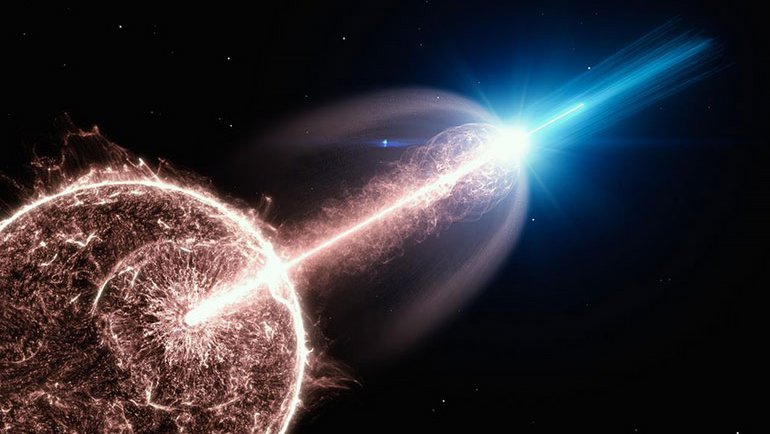Bazı yıldızlar öldüğünde çöker ve süpernovaya dönüşürler, bu sırada gama ışını patlamaları olarak bilinen parlak gama ışınları ve X-ışınları parlamaları oluştururlar. Gama ışını patlamaları, evrende bilinen en büyük patlamalar ve kısa süre önce bilim insanlarının, bir tanesini hiç olmadığı kadar yakından gözlemleme imkanı bulduğu duyuruldu.
NASA’nın Fermi ve Swift uyduları, 29 Ağustos 2019’da Eridanus takımyıldızı yönünde bir gama ışını patlaması tespit etti. Patlama, GRB 190829A olarak kataloglandı ve neredeyse anında dünyanın dört bir yanındaki gözlemevleri, kozmik olay hakkında daha fazla veri toplamak için otomatik olarak bu noktaya odaklandı. Patlamanın bir milyar ışık yılı uzakta gerçekleştiği tespit edildi. Dünya için tehlike yaratmayacak kadar uzak ancak yine de şimdiye kadar gözlemlenen en yakın patlamadan 20 kat daha yakındı.
Bu müthiş patlamayı aşağıdan izleyebilirsiniz:
 Gamma-ray Burst in Our Cosmic Backyard / Gammablitz aus der kosmischen NachbarschaftTurn on subtitles for explanation. – Für Beschreibung Untertitel aktivieren. (Switch language via settings) Somewhere in a distant galaxy, a massive dying star collapses and a neutron star or black hole forms. Relativistic jets break out of the collapsing star, and a supernova is produced. The jet ploughs through the surrounding gas sweeping up particles. Some particles scatter on magnetic fields around the blast wave and are accelerated. The accelerated electrons emit high energy photons in the X-ray and gamma-ray regime at every deflection. This emission is called synchrotron radiation. Relativistic beaming occurs in the jet direction. When looking exactly down a jet, the event becomes visible as a gamma-ray burst (GRB). Roughly 900 million years later, radiation from this gamma-ray burst arrives at Earth and is detected by satellites and telescopes as GRB 190829A. High-energy photons hitting Earth’s atmosphere produce particle showers that emit so-called Cherenkov light for a couple of nanoseconds. This glow can be detected by telescopes such as H.E.S.S. This way, H.E.S.S. could follow GRB 190829A for three nights in a row in unprecedented detail. * * * In einer fernen Galaxie kollabiert ein massereicher, sterbender Stern, es entsteht ein Neutronenstern oder ein Schwarzes Loch. Dabei formen sich zwei senkrechte relativistische Plasmastrahlen, die die Sternenhülle durchbrechen. Der Stern explodiert schließlich in einer Supernova. Die Plasmastrahlen (Jets) pflügt durch das umgebende Gas und sammeln Elektronen auf. Diese Elektronen werden durch Magnetfelder im Jet abgelenkt und an der Schockwelle beschleunigt. Bei jeder Ablenkung senden die schnellen Elektronen dann Lichtteilchen im Bereich der Röntgen- und Gammastrahlung aus. Dieses Licht heißt Synchrotronstrahlung und ist durch relativistische Effekte in Richtung des Plasmastrahls gebündelt. Blickt man genau von vorne in den Jet, wird das Ereignis als Gammablitz (Gamma Ray Burst) sichtbar. Rund 900 Millionen Jahre später erreicht die Strahlung dieses Gamma Ray Bursts die Erde und wird von Satelliten und Teleskopen als GRB 190829A registriert. Energiereiche Lichtteilchen (Photonen) erzeugen Teilchenschauer beim Eintritt in die Atmosphäre. Diese Teilchenschauer senden für einige Nanosekunden sogenanntes Tscherenkow-Licht aus, das von Teleskopen wie H.E.S.S. gemessen werden kann. H.E.S.S. konnte das Nachglühen von GRB 190829A auf diese Weise über drei Nächte und in zuvor unerreichtem Detailreichtum verfolgen. Animation: DESY, Science Communication Lab (“Swift” model data from NASA model database) Read more about this exciting discovery at Weitere Informationen unter
Gamma-ray Burst in Our Cosmic Backyard / Gammablitz aus der kosmischen NachbarschaftTurn on subtitles for explanation. – Für Beschreibung Untertitel aktivieren. (Switch language via settings) Somewhere in a distant galaxy, a massive dying star collapses and a neutron star or black hole forms. Relativistic jets break out of the collapsing star, and a supernova is produced. The jet ploughs through the surrounding gas sweeping up particles. Some particles scatter on magnetic fields around the blast wave and are accelerated. The accelerated electrons emit high energy photons in the X-ray and gamma-ray regime at every deflection. This emission is called synchrotron radiation. Relativistic beaming occurs in the jet direction. When looking exactly down a jet, the event becomes visible as a gamma-ray burst (GRB). Roughly 900 million years later, radiation from this gamma-ray burst arrives at Earth and is detected by satellites and telescopes as GRB 190829A. High-energy photons hitting Earth’s atmosphere produce particle showers that emit so-called Cherenkov light for a couple of nanoseconds. This glow can be detected by telescopes such as H.E.S.S. This way, H.E.S.S. could follow GRB 190829A for three nights in a row in unprecedented detail. * * * In einer fernen Galaxie kollabiert ein massereicher, sterbender Stern, es entsteht ein Neutronenstern oder ein Schwarzes Loch. Dabei formen sich zwei senkrechte relativistische Plasmastrahlen, die die Sternenhülle durchbrechen. Der Stern explodiert schließlich in einer Supernova. Die Plasmastrahlen (Jets) pflügt durch das umgebende Gas und sammeln Elektronen auf. Diese Elektronen werden durch Magnetfelder im Jet abgelenkt und an der Schockwelle beschleunigt. Bei jeder Ablenkung senden die schnellen Elektronen dann Lichtteilchen im Bereich der Röntgen- und Gammastrahlung aus. Dieses Licht heißt Synchrotronstrahlung und ist durch relativistische Effekte in Richtung des Plasmastrahls gebündelt. Blickt man genau von vorne in den Jet, wird das Ereignis als Gammablitz (Gamma Ray Burst) sichtbar. Rund 900 Millionen Jahre später erreicht die Strahlung dieses Gamma Ray Bursts die Erde und wird von Satelliten und Teleskopen als GRB 190829A registriert. Energiereiche Lichtteilchen (Photonen) erzeugen Teilchenschauer beim Eintritt in die Atmosphäre. Diese Teilchenschauer senden für einige Nanosekunden sogenanntes Tscherenkow-Licht aus, das von Teleskopen wie H.E.S.S. gemessen werden kann. H.E.S.S. konnte das Nachglühen von GRB 190829A auf diese Weise über drei Nächte und in zuvor unerreichtem Detailreichtum verfolgen. Animation: DESY, Science Communication Lab (“Swift” model data from NASA model database) Read more about this exciting discovery at Weitere Informationen unter





















Bir cevap yazın